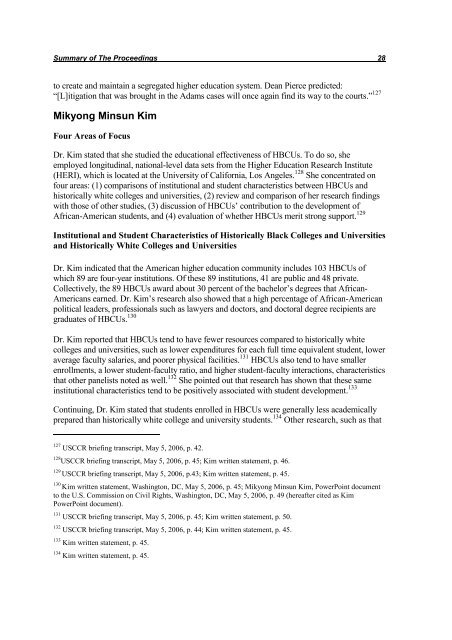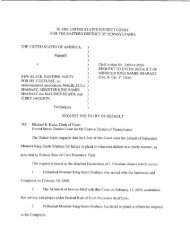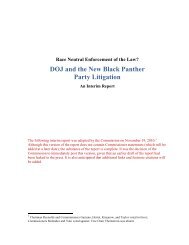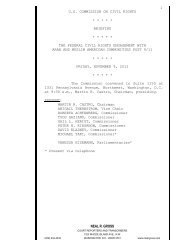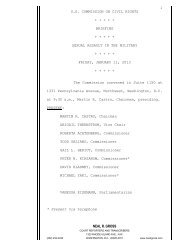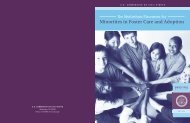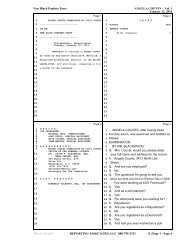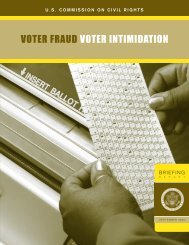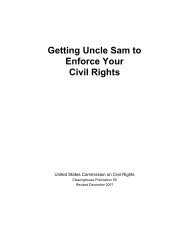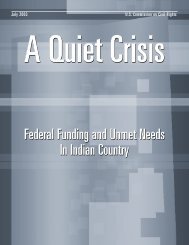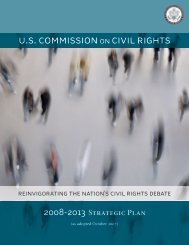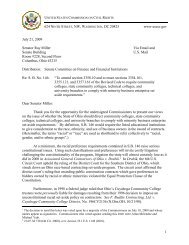The Educational Effectiveness of Historically Black Colleges and ...
The Educational Effectiveness of Historically Black Colleges and ...
The Educational Effectiveness of Historically Black Colleges and ...
You also want an ePaper? Increase the reach of your titles
YUMPU automatically turns print PDFs into web optimized ePapers that Google loves.
Summary <strong>of</strong> <strong>The</strong> Proceedings 28<br />
to create <strong>and</strong> maintain a segregated higher education system. Dean Pierce predicted:<br />
“[L]itigation that was brought in the Adams cases will once again find its way to the courts.” 127<br />
Mikyong Minsun Kim<br />
Four Areas <strong>of</strong> Focus<br />
Dr. Kim stated that she studied the educational effectiveness <strong>of</strong> HBCUs. To do so, she<br />
employed longitudinal, national-level data sets from the Higher Education Research Institute<br />
(HERI), which is located at the University <strong>of</strong> California, Los Angeles. 128 She concentrated on<br />
four areas: (1) comparisons <strong>of</strong> institutional <strong>and</strong> student characteristics between HBCUs <strong>and</strong><br />
historically white colleges <strong>and</strong> universities, (2) review <strong>and</strong> comparison <strong>of</strong> her research findings<br />
with those <strong>of</strong> other studies, (3) discussion <strong>of</strong> HBCUs’ contribution to the development <strong>of</strong><br />
African-American students, <strong>and</strong> (4) evaluation <strong>of</strong> whether HBCUs merit strong support. 129<br />
Institutional <strong>and</strong> Student Characteristics <strong>of</strong> <strong>Historically</strong> <strong>Black</strong> <strong>Colleges</strong> <strong>and</strong> Universities<br />
<strong>and</strong> <strong>Historically</strong> White <strong>Colleges</strong> <strong>and</strong> Universities<br />
Dr. Kim indicated that the American higher education community includes 103 HBCUs <strong>of</strong><br />
which 89 are four-year institutions. Of these 89 institutions, 41 are public <strong>and</strong> 48 private.<br />
Collectively, the 89 HBCUs award about 30 percent <strong>of</strong> the bachelor’s degrees that African-<br />
Americans earned. Dr. Kim’s research also showed that a high percentage <strong>of</strong> African-American<br />
political leaders, pr<strong>of</strong>essionals such as lawyers <strong>and</strong> doctors, <strong>and</strong> doctoral degree recipients are<br />
graduates <strong>of</strong> HBCUs. 130<br />
Dr. Kim reported that HBCUs tend to have fewer resources compared to historically white<br />
colleges <strong>and</strong> universities, such as lower expenditures for each full time equivalent student, lower<br />
average faculty salaries, <strong>and</strong> poorer physical facilities. 131 HBCUs also tend to have smaller<br />
enrollments, a lower student-faculty ratio, <strong>and</strong> higher student-faculty interactions, characteristics<br />
that other panelists noted as well. 132 She pointed out that research has shown that these same<br />
institutional characteristics tend to be positively associated with student development. 133<br />
Continuing, Dr. Kim stated that students enrolled in HBCUs were generally less academically<br />
prepared than historically white college <strong>and</strong> university students. 134 Other research, such as that<br />
127 USCCR briefing transcript, May 5, 2006, p. 42.<br />
128 USCCR briefing transcript, May 5, 2006, p. 45; Kim written statement, p. 46.<br />
129 USCCR briefing transcript, May 5, 2006, p.43; Kim written statement, p. 45.<br />
130 Kim written statement, Washington, DC, May 5, 2006, p. 45; Mikyong Minsun Kim, PowerPoint document<br />
to the U.S. Commission on Civil Rights, Washington, DC, May 5, 2006, p. 49 (hereafter cited as Kim<br />
PowerPoint document).<br />
131 USCCR briefing transcript, May 5, 2006, p. 45; Kim written statement, p. 50.<br />
132 USCCR briefing transcript, May 5, 2006, p. 44; Kim written statement, p. 45.<br />
133 Kim written statement, p. 45.<br />
134 Kim written statement, p. 45.


